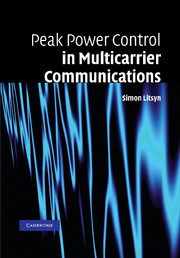Book contents
- Frontmatter
- Contents
- List of figures
- List of abbreviations
- List of notation
- 1 Introduction
- 2 Multicarrier signals
- 3 Basic tools and algorithms
- 4 Discrete and continuous maxima in MC signals
- 5 Statistical distribution of peak power in MC signals
- 6 Coded MC signals
- 7 MC signals with constant PMEPR
- 8 Methods to decrease peak power in MC systems
- Bibliography
- Index
3 - Basic tools and algorithms
Published online by Cambridge University Press: 03 December 2009
- Frontmatter
- Contents
- List of figures
- List of abbreviations
- List of notation
- 1 Introduction
- 2 Multicarrier signals
- 3 Basic tools and algorithms
- 4 Discrete and continuous maxima in MC signals
- 5 Statistical distribution of peak power in MC signals
- 6 Coded MC signals
- 7 MC signals with constant PMEPR
- 8 Methods to decrease peak power in MC systems
- Bibliography
- Index
Summary
In this chapter I collect the basic mathematical tools which are used throughout the book. Most of them are given with rigorous proofs. I mainly concentrate here on results and methods that do not appear in the standard engineering textbooks and omit those that happen to be common technical knowledge. On the other hand, I have included some material that is not directly used in further arguments, but I feel that it might prove useful in further research on peak power control problems. It should be advised that the chapter is mainly for reference purposes and may be omitted in the first reading.
The chapter is organized as follows. Section 3.1 deals with harmonic analysis. In Section 3.1.1 I describe the Parseval equality and its generalizations. Section 3.1.2 introduces some useful trigonometric relations. Chebyshev polynomials and interpolation are described in Section 3.1.3. Finally, in Section 3.1.4, I prove Bernstein's inequality relating the maximum of the absolute value of a trigonometric polynomial and its derivative. In Section 3.2 I deal with some notions related to probability. I prove the Chernoff bound on the probability of deviations of values of random variables. In Section 3.3, I introduce tools from algebra. In Section 3.3.1 groups, rings, and fields are defined. Section 3.3.2 describes exponential sums in finite fields and rings. A short account of results from coding theory is presented in Section 3.4. Section 3.4.1 deals with properties of the Hamming space. In Section 3.4.2, definitions related to error-correction codes are introduced. Section 3.4.3 deals with the distance distributions of codes. In Section 3.4.4, I analyze properties of Krawtchouk polynomials playing an important role in the Mac Williams transform of the distance distributions.
Information
- Type
- Chapter
- Information
- Peak Power Control in Multicarrier Communications , pp. 17 - 67Publisher: Cambridge University PressPrint publication year: 2007
